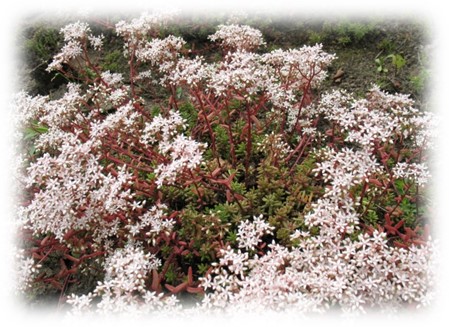CONTENT OF BIOLOGICALLY ACTIVE SUBSTANCES IN THE ABOVEGROUND PART OF SOME STONECROPS (SEDOIDEAE)
UDC 582.711.16:581.19(571.1)
Abstract
The results of a comparative study of the content of biologically active substances in 8 species of the Sedoideae subfamily Aizopsis aizoon (L.) Grulich, A. hybrida (L.) Grulich, A. kurilensis (Vorosch.) S. Gontch., Hylotelephium ewersii (Ledeb.) H. Ohba, Sedum album L., S. hispanicum L., S. rupestre L., S. spurium M. Bieb. are presented: The aboveground shoots collected during the mass flowering phase were analyzed. The dry matter content was determined by drying of raw materials at 100‒105 °C. The amount of phenolic compounds, pectin substances, and total sugars was determined spectrophotometrically using SF-56 (Russia) and Agilent 8453 UV-Vis (USA) devices; the concentration of ascorbic acid was determined by titrimetric method. It was established the content of dry substances (up to 18.94%), flavonols (up to 4.45%), catechins (up to 3.72%), tannins (up to 20.2%), pectins (up to 13.36%), and sugars (up to 39.54%) per mass of absolutely dry raw materials, and ascorbic acid – up to 123.7 mg% per raw mass. A. kurilensis has the greatest capacity to accumulate bioactive substances. The data point to the prospects of stonecrops as a potential source for the production of food and feed additives.
Downloads
Metrics
References
Krasnov Ye.A., Saratikov A.S., Surov Yu.P. Rasteniya semeystva tolstyankovykh. [Plants of the Crassulaceae family]. Tomsk, 1979, 208 p. (in Russ.).
Gendaram O., Choi Y.H., Kim Y.S., Ryu S.Y. Naturae Product Science, 2011, vol. 17, no. 4, pp. 279‒284.
Dzjuba O.I., Gatsenko M.V. Ecology and Noospherology, 2014, vol. 25, no. 3‒4, pp. 24‒33. DOI: 10.15421/031417.
Xu T., Wang Z., Lei T., Lv C., Wang J., Lu J. Fitoterapia, 2015, vol. 101, pp. 125‒132. DOI: 10.1016/j.fitote.2014.12.014.
Kim J.H., 'T Hart H., Stevens J.F. Phytochemistry, 1996, vol. 41, no. 5, pp. 1319‒1324. DOI: 10.1016/0031-9422(95)00562-5.
Gerelt-Od Ya., Solongo A., Javzan S., Philipov S., Selenge D. Mongolian J. of Chemistry, 2015, vol. 16, no. 42, pp. 44‒47.
Revina T.A. Introduktsiya rasteniy Sibiri i Dal'nego Vostoka. [Introduction of plants in Siberia and the Far East]. No-vosibirsk, 1983, pp. 105‒109. (in Russ.).
Korul'kin D.Yu., Kurbatova N.V., Muzychkina R.A. Vestnik KazNU. Seriya biologicheskaya, 2016, no. 3(68), pp. 62‒71. (in Russ.).
Rastitel'nyye resursy SSSR: Tsvetkovyye rasteniya, ikh khimicheskiy sostav, ispol'zovaniye; Semeystva Caprifoliaceae-Plantaginaceae. [Plant resources of the USSR: Flowering plants, their chemical composition, use; Families Caprifoli-aceae-Plantaginaceae]. Leningrad, 1990, 328 p. (in Russ.).
Jin C., Wei X., Yang S., Gao L., Gong G. Food Science and Technology Research, 2017, vol. 23, no. 1, pp. 111‒118. DOI: 10.3136/fstr.23.111.
Konovalova T.Yu., Shevyreva N.A. Ochitki i drugiye tolstyankovyye. [Stonecrops and other Crassulaceae]. Moscow, 2006, 95 p. (in Russ.).
Goncharova S., Koldayeva M., Belukha A. Tsvetovodstvo, 2011, no. 5, pp. 20‒24. (in Russ.).
Kukushkina T.A., Zykov A.A., Obukhova L.A. Aktual'nyye problemy sozdaniya novykh lekarstvennykh preparatov prirodnogo proiskhozhdeniya: Mater. VII Mezhdunar.s"yezda. [Actual problems of creating new drugs of natural origin: Proceedings of the VII International Congress]. St. Petersburg, 2003, pp. 64–69. (in Russ.).
Belikov V.V., Shrayber M.S. Farmatsiya, 1970, no. 1, pp. 66–72. (in Russ.).
Fedoseyeva L.M. Khimiya rastitel'nogo syr'ya, 2005, no. 2, pp. 45–50. (in Russ.).
Metody biokhimicheskogo issledovaniya rasteniy [Methods of biochemical research of plants], ed. A.I. Yermakov. Len-ingrad, 1987, 420 p. (in Russ.).
Kriventsov V.I. Sbornik nauchnykh trudov Gosudarstvennogo Nikitskogo botanicheskogo sada, 1989, vol. 109, pp. 128–137. (in Russ.).
Ertaş A., Boğa M., Yilmaz M.A., Yeşil Ye., Haşimi N., Kaya M.Ş., Temel H., Kolak U. J. of Agricultural and Food Chemistry, 2014, vol. 62, no. 20, pp. 4601–4609. DOI: 10.1021/jf500067q.
Tarakhovskiy Yu.S., Kim Yu.A., Abdrasilov B.S., Muzafarov E.N. Flavonoidy: biokhimiya, biofizika, meditsina. [Fla-vonoids: biochemistry, biophysics, medicine]. Pushchino, 2013, 310 p. (in Russ.).
Mo E.K., Kim S.M., Yang S.A., Oh C.J., Sung C.K. Food Science and Biotechnology, 2011, vol. 20, 1061. DOI: 10.1007/s10068-011-0144-0.
Phenolic compounds: fundamental and applied aspects, ed. N.V. Zagoskina, E.B. Burlakova. Moscow, 2010. 400 p.
Li M., Chen X., Wang P., Ma F. J. of the American Society for Horticultural Science, 2011, vol. 136, pp. 231–238.
Gubanova T.B. Byulleten' Gosudarstvennogo Nikitskogo botanicheskogo sada, 2015, vol. 115, pp. 61‒66. (in Russ.).
Kukushkina T.A., Fomina T.I. Agrarnyy vestnik Urala, 2021, no. 04(207), pp. 85‒92. DOI: 10.32417/1997-4868-2021-207-04-85-92. (in Russ.).
Gubanova T.V. Byulleten' Gosudarstvennogo Nikitskogo botanicheskogo sada, 2008, vol. 96, pp. 68‒71. (in Russ.).
Minzanova S.T., Mironov V.F., Arkhipova D.M., Khabibulina A.V., Mironova L.G., Zakirova Yu,M., Milyakov V.A. Polymers, 2018, vol. 10, 1407. DOI: 10.3390/polym10121407.

Copyright (c) 2022 chemistry of plant raw material

This work is licensed under a Creative Commons Attribution 4.0 International License.

This work is licensed under a Creative Commons Attribution 4.0 International License.
The authors, which are published in this journal, agree to the following conditions:
1. Authors retain the copyright to the work and transfer to the journal the right of the first publication along with the work, at the same time licensing it under the terms of the Creative Commons Attribution License, which allows others to distribute this work with the obligatory indication of the authorship of this work and a link to the original publication in this journal .
2. The authors retain the right to enter into separate, additional contractual agreements for the non-exclusive distribution of the version of the work published by this journal (for example, to place it in the university depository or to publish it in a book), with reference to the original publication in this journal.
3. Authors are allowed to post their work on the Internet (for example, in a university repository or on their personal website) before and during the review process of this journal, as this may lead to a productive discussion, as well as more links to this published work.











